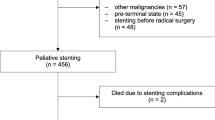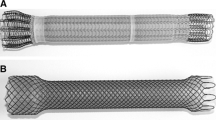Abstract
Purpose
To evaluate the clinical results of the use of biodegradable oesophageal stents in malignant strictures.
Methods
Eleven patients were included in this prospective analysis in which a woven polydioxanone biodegradable oesophageal stent was used. The inclusion criterion was that the patient underwent neoadjuvant treatment or radical radiotherapy after the stent insertion. Primary end points were dysphagia score at discharge, stent patency, and complication rate. Secondary end points were overall survival and surgical outcome of surgery.
Results
There was a 100 % procedure technical success rate. Early complications occurred in three patients resulting in failure to restore oral nutrition. In the remaining eight patients, dysphagia was significantly improved at discharge. Mean stent patency rate in this group was 71.5 days. Stent dysfunction occurred in five of eight patients (62.5 %); in two of five patients this was due to local inflammatory reaction, and in three of five patients it was due to tumour growth after a mean time of 97.8 days, and a new metallic stent was consequently placed in four of five patients. One patient was successfully treated with esophagectomy. At the end of follow-up (mean time 102.1 days), three of eight stents were patent. The overall patient survival rate was 81.8 %.
Conclusion
Although short-term dysphagia scores improved, biodegradable stents do not appear to offer a clear beneficial effect in most cases of malignant strictures, particularly due to a local inflammatory reaction that may be induced. Technical improvement of the device and delineation of the patient group that would benefit from its use is necessary if further studies are to be conducted in the future.



Similar content being viewed by others
References
Katsanos K, Sabharwal T, Adam A (2010) Stenting of the upper gastrointestinal tract current status. Cardiovasc Interv Radiol 33(4):690–705
Adler DG, Fang J, Wong R, Wills J, Hilden K (2009) Placement of polyflex stents in patients with locally advanced esophageal cancer is safe and improves dysphagia during neoadjuvant therapy. Gastrointest Endosc 70(4):614–619
Bower M, Jones W, Vessels B, Scoggins C, Martin R (2009) Nutritional support with endoluminal stenting during neoadjuvant therapy for esophageal malignancy. Ann Surg Oncol 16(11):3161–3168
Langer FB, Schoppmann SF, Prager G, Tomaselli F, Pluschnig U, Hejna M et al (2010) Temporary placement of self-expanding oesophageal stents as bridging for neo-adjuvant therapy. Ann Surg Oncol 17(2):470–475
Lopes TL, Eloubeidi MA (2010) A pilot study of fully covered self-expandable metal stents prior to neoadjuvant therapy for locally advanced esophageal cancer. Dis Esophagus 23(4):309–315
Siddiqui AA, Loren D, Dudnick R, Kowalski T (2007) Expandable polyester silicon-covered stent for malignant esophageal strictures before neoadjuvant chemoradiation: a pilot study. Dig Dis Sci 52:823–829
Repici A, Vleggaar FP, Hassan C, van Boeckel PG, Romeo F, Pagano N et al (2010) Efficacy and safety of biodegradable stents for refractory benign esophageal strictures: the best (biodegradable esophageal stent) study. Gastrointest Endosc 72(5):927–934
Saito Y, Tanaka T, Andoh A, Minematsu H, Hata K, Tsujikawa T et al (2007) Usefulness of biodegradable stents constructed of poly-l-lactic acid monofilaments in patients with benign esophageal stenosis. World J Gastroenterol 13(29):3977–3980
Stivaros SM, Williams LR, Senger C, Wilbraham L, Laasch HU (2010) Woven polydioxanone biodegradable stents: a new treatment option for benign and malignant oesophageal strictures. Eur Radiol 20(5):1069–1072
Griffiths E, Gregory C, Pursnani G, Ward JB, Stockwell RC (2012) The use of biodegradable (SX-ELLA) oesophageal stents to treat dysphagia due to benign and malignant oesophageal disease. Surg Endosc 26:2367–2375
Mellow MH, Pinkas H (1985) Endoscopic laser therapy for malignancies affecting the esophagus and gastroesophageal junction. Analysis of technical and functional efficacy. Arch Intern Med 145:1443–1446
Reynolds JV, Muldoon C, Hollywood D, Ravi N, Rowley S, O’Byrne K et al (2007) Long-term outcomes following neoadjuvant chemo radiotherapy for esophageal cancer. Ann Surg 245:707–716
Forastiere AA, Orringer MB, Perez-Tamayo C, Urba SG, Zahurak M (1993) Preoperative chemoradiation followed by transhiatalesophagectomy for carcinoma of the esophagus: final report. J Clin Oncol 11:1118–1123
Papachristou GI, Baron TH (2007) Use of stents in benign and malignant esophageal disease. Rev Gastroenterol Disord 7(2):74–88
Costamagna G, Shah SK, Tringali A, Mutignani M, Perri V, Riccioni ME (2003) Prospective evaluation of a new self-expanding plastic stent for inoperable esophageal strictures. Surg Endosc 17:891–895
Dormann AJ, Eisendrath P, Wigginghaus B, Huchzermeyer H, Devière J (2003) Palliation of esophageal carcinoma with a new self-expanding plastic stent. Endoscopy 35:207–211
Li XA, Chibani O, Greenwald B, Suntharalingam M (2002) Radiotherapy dose perturbation of metallic esophageal stents. Int J Radiat Oncol Biol Phys 54:1276–1285
HooftJE V, van Berge Henegouwen MI, Rauws EA, Bergman JJ, Busch OR, Fockens P (2011) Endoscopic treatment of benign anastomotic esophagogastric strictures with a biodegradable stent. Gastrointest Endosc 73(5):1043–1047
Hair CS, Devonshire DA (2010) Tissue stenosis of biodegradable stent. Endoscopy 42(Suppl 2):E132–E133
Güitrón-Cantú A, Adalid-Martínez R, Gutiérrez-Bermúdez J, Meza Mata E, Segura López F, García Vázquez A (2010) Foreign body reaction of a biodegradable esophageal stent. A case report [in Spanish]. Rev Gastroenterol Mex 75(2):203–207
Conflict of Interest
Miltiadis Krokidis, Chris Burke, Stavros Spiliopoulos, Panos Gkoutzios, Orla Hynes, Irfan Ahmed, Renato Dourado, Tarun Sabharwal, Robert Mason, Andreas Adam have no conflict of interest
Author information
Authors and Affiliations
Corresponding author
Rights and permissions
About this article
Cite this article
Krokidis, M., Burke, C., Spiliopoulos, S. et al. The Use of Biodegradable Stents in Malignant Oesophageal Strictures for the Treatment of Dysphagia Before Neoadjuvant Treatment or Radical Radiotherapy: A Feasibility Study. Cardiovasc Intervent Radiol 36, 1047–1054 (2013). https://doi.org/10.1007/s00270-012-0503-0
Received:
Accepted:
Published:
Issue Date:
DOI: https://doi.org/10.1007/s00270-012-0503-0




